 Annapoorneshwari Temple is also called "Sri Kshethra Horanadu". It is situated on the banks of river Bhadra in Chikmaglur district of Karnataka, surrounded by the natural beauty of the Western Ghats. This temple is dedicated to Goddess Annapoorneshwari who has been restored and renamed as the Adi-Shaktyatmaka Shree Annapoorneshwari. Goddess Annapoorneshwari stands on a peetha with Shanku, Chakra, Sri Chakra and Devi Gayathri in her four hands.
Annapoorneshwari Temple is also called "Sri Kshethra Horanadu". It is situated on the banks of river Bhadra in Chikmaglur district of Karnataka, surrounded by the natural beauty of the Western Ghats. This temple is dedicated to Goddess Annapoorneshwari who has been restored and renamed as the Adi-Shaktyatmaka Shree Annapoorneshwari. Goddess Annapoorneshwari stands on a peetha with Shanku, Chakra, Sri Chakra and Devi Gayathri in her four hands.
The great deity of Adishakthyathmaka Sri Annapoorneshwari`s prathistapana was done by sage Agasthya. Till the 5th Dharmakartharu, the temple had a very small structure surrounded by full of natural vegetation and forest. Annapoorneshwari means "Feeding one and all". People who visit this temple are provided with breakfast, lunch, dinner and tea and coffee. It is believed that once Lord Shiva was cursed. When he came here and accepted alms from Annapoorneshwari, the curse was lifted.
This article is a stub. You can enrich by adding more information to it. Send your Write Up to content@indianetzone.com





















